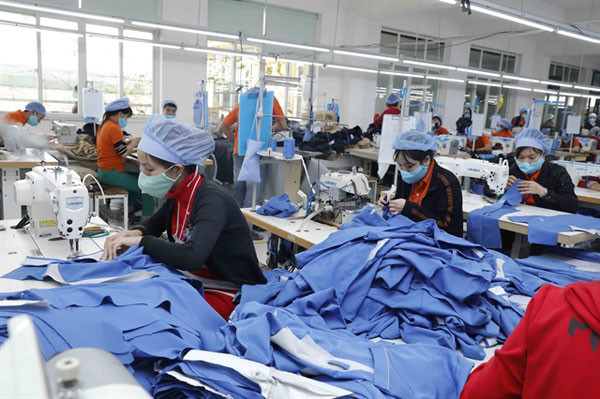
The Government has set out a new plan for the future development of Vietnam, with increased incomes, modern industry, strong infrastructure and measures in place to protect the environment.
This is part of the Government's recently issued resolution on the national master plan for the 2021-2030 period, which aims to turn Vietnam into a developed and high-income country with GDP per capita reaching about US$27,000-32,000 by 2050.
As part of the plan, Vietnam strives to become an upper middle-income country with a modern industrial base by 2030.
The national master plan, signed by Deputy Prime Minister Le Van Thanh, will be submitted to the National Assembly for approval.
As an upper middle-income country with a modern industrial base, Vietnam will have efficient, unified and sustainable national development spaces with dynamic economic and urban centres and a modern infrastructure network.
The country will have the capacity to maintain major balances, improve economic resilience, ensure energy security, food security and water sources, and at the same time protect the ecological environment and adapt to climate change.
People's material and spiritual life will be enhanced and national defence and security guaranteed.
Vietnam will strive to obtain an average GDP growth of about 7 per cent in the 2021-2030 period, of which the southeast region and the Red River Delta will increase by 8-8.5 per cent.
By 2030, GDP per capita is expected to reach about $7,500. The proportion in GDP of the service sector will be more than 50 per cent, the industry and construction sector over 40 per cent, and the agriculture, forestry and fishery sector less than 10 per cent. The contribution of total factor productivity (TFP) to national growth will reach 50 per cent.
The country will target to form two dynamic zones associated with the growth poles in Hanoi and HCM City. There will be economic corridors in the North-South, Lao Cai – Hanoi – Hai Phong – Quang Ninh, and Moc Bai – HCM City – Vung Tau.
The plan will focus on modern infrastructure, development spaces in association with the national urban area system, and green and smart urban areas. Connectivity between urban and rural areas will be enhanced, with an urbanisation rate of more than 50 per cent.
Digital transformation will be prioritised, focusing on digital government, digital economy and digital society. The share of the digital economy will be about 30 per cent of GDP.
By 2030, the population is expected to reach about 105 million. The Human Development Index (HDI) targets to remain above 0.7 and the average life expectancy will be 75 years, of which the healthy life expectancy is at least 68 years.
The average residential floor area per capita in urban areas will be at least 32 square metres.
In terms of education, Vietnam sets a target to upgrade the education system to an advanced level in the region, ranking among the top ten countries with the best higher education systems in Asia.
The ratio of university students will reach 260 per 10,000 people and the rate of trained workers with degrees and certificates will be 35-40 per cent of the total.

In terms of healthcare services, the country will improve its services on par with advanced countries in the region with a national network of medical facilities to improve the health of the entire population.
By 2030, Vietnam will have 35 hospital beds and 19 doctors per 10,000 people at public facilities.
High-income status
Also under the plan, Vietnam has set an ambitious goal of reaching high-income status by 2050.
In this period, Vietnam will obtain an average growth rate of GDP of 6.5-7.5 per cent. GDP per capita is expected to reach about $27,000-32,000. The urbanisation rate will reach 70-75 per cent.
The country will become a democratic and civilised society equipped with a modern and synchronous infrastructure system and harmonious and sustainable development among regions.
The country's goals include a smart, modern and green urban system, good quality environment, effective development towards a circular economy, green economy and low carbon emissions, high human development index and guaranteed national defence and security.
To achieve these goals, the Government has chalked out key tasks.
The country needed to form a basic framework of national infrastructure, focusing on transport infrastructure, energy, urban areas, digital infrastructure, environmental protection, irrigation, disaster prevention, adaptation to climate change and cultural and social infrastructure.
In addition, it should accelerate economic restructuring and development spaces, ensuring productivity, quality and efficiency improvement; and prioritise the development of a number of industries and fields that have the potential to serve as a driving force for growth and economic autonomy.
The country also needed to develop important growth poles, and selected a number of regions with special advantages to build economic and financial centres, administrative-economic units with special mechanisms and policies to improve international competitiveness. Appropriate mechanisms and policies for the development of remote areas, border areas and islands will also be promoted.
Forming and developing economic corridors connecting seaports, airports, international border gates, major trading hubs, urban centers and economic centers will be carried out.
The development spaces will be divided into six zones – northern midland and mountainous region (14 provinces); the Red River Delta region (11 cities and provinces); the north central coast and central coast (14 cities and provinces), the Central Highlands (five provinces), the southeast region (six cities and provinces), and the Mekong Delta region (11 cities and provinces).
The Ministry of Planning and Investment is to receive opinions from the Politburo and the Party Central Committee and complete the national master plan and submit it to the National Assembly for approval.
The ministry will be in charge of reporting to the Prime Minister on the completion of the national master plan before submitting it to the National Assembly.
Source: Vietnam News